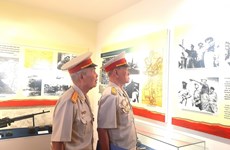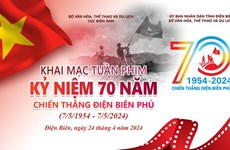Nam Dinh to celebrate royal heritage
A number of events beginning later this month will celebrate the 750th
anniversary of Thien Truong, the old capital of the Tran dynasty
(1225-1400) in the northern province of Nam Dinh.
A number of events beginning later this month will celebrate the 750th
anniversary of Thien Truong, the old capital of the Tran dynasty
(1225-1400) in the northern province of Nam Dinh.
A ceremony will be held in Nam Dinh city on October 5, including a military march and public parade, followed by a ceremony in which the Ho Chi Minh Order will be conferred by the Prime Minister, recognising Nam Dinh as a Category One city.
The city's Tran Temple will also be officially recognised in the ceremony as an historical and architectural site, while Pho Minh Pagoda will be designated a special national relic.
A performance and fireworks show will take place that night, with the whole celebration throughout the day to be broadcast live on Vietnam Television's VTV1 channel.
As recorded by Ngo Sy Lien, in the Dai Viet Su Ky Toan Thu (Complete Annals of the Dai Viet), the Tran dynasty in 1225 took power from the Ly dynasty. In 1239, King Tran Thai Tong, whose birthplace was Tuc Mac village, Thien Truong district, now the city of Nam Dinh, ordered a royal complex built there, called Tuc Mac, and a temple to worship ancestors, all of which were upgraded into the Thien Truong Palace complex in 1262. The complex, consisting of Trung Quang Palace and Trung Hoa Palace , served as a special administrative and political centre to the south of the kingdom's capital city of Thang Long ( Hanoi ).
During three wars against Mongol invaders in the 13th century, Tran kings stayed at the Thien Truong complex, where they stored provisions and trained the army. Under succeeding dynasties, the area played a key role in broadening the plain near the sea, reclaiming the land that makes up today's fertile Hong (Red) River delta plain.
In addition to its important place in the country's political history, the area has also been famed for its talented people and learning traditions. At the royal exam in 1247, 13-year-old local Nguyen Hien won the highest score and became one of the youngest to receive the doctoral title in the feudal period. In 1281, the Tran dynasty built an institute in the area to recruit and train intellectuals. Since then, the locality has maintained the tradition of learning, nurturing such talents as Kings Tran Thai Tong, Tran Thanh Tong and Tran Nhan Tong, General Tran Quoc Tuan, and 20th-century revolutionaries like Truong Chinh, Tran Van Lan, Le Duc Tho, Tong Van Tran and Nguyen Co Thach.
In the 20th century, Nam Dinh was a cradle for nationalist and workers' movements, and locals made considerable contributions to the war against the US and the cause of building socialism.
An exhibition on the socio-economic development of the area will open on Sept 25 at Vi Xuyen Park in the city. A handicrafts and tourism fair will also kick off that night at Hoa Binh Square , and a bonsai exhibition gathering decorative plants by artisans from all over the Hong (Red) River region will open near the Tran Temple .
A few days later, on Sept. 29, the city will host an international conference on the culture of Mother God worship in Vietnam and Asia . The next day, an antiques exhibition will be held at Nam Dinh Museum.-VNA
A ceremony will be held in Nam Dinh city on October 5, including a military march and public parade, followed by a ceremony in which the Ho Chi Minh Order will be conferred by the Prime Minister, recognising Nam Dinh as a Category One city.
The city's Tran Temple will also be officially recognised in the ceremony as an historical and architectural site, while Pho Minh Pagoda will be designated a special national relic.
A performance and fireworks show will take place that night, with the whole celebration throughout the day to be broadcast live on Vietnam Television's VTV1 channel.
As recorded by Ngo Sy Lien, in the Dai Viet Su Ky Toan Thu (Complete Annals of the Dai Viet), the Tran dynasty in 1225 took power from the Ly dynasty. In 1239, King Tran Thai Tong, whose birthplace was Tuc Mac village, Thien Truong district, now the city of Nam Dinh, ordered a royal complex built there, called Tuc Mac, and a temple to worship ancestors, all of which were upgraded into the Thien Truong Palace complex in 1262. The complex, consisting of Trung Quang Palace and Trung Hoa Palace , served as a special administrative and political centre to the south of the kingdom's capital city of Thang Long ( Hanoi ).
During three wars against Mongol invaders in the 13th century, Tran kings stayed at the Thien Truong complex, where they stored provisions and trained the army. Under succeeding dynasties, the area played a key role in broadening the plain near the sea, reclaiming the land that makes up today's fertile Hong (Red) River delta plain.
In addition to its important place in the country's political history, the area has also been famed for its talented people and learning traditions. At the royal exam in 1247, 13-year-old local Nguyen Hien won the highest score and became one of the youngest to receive the doctoral title in the feudal period. In 1281, the Tran dynasty built an institute in the area to recruit and train intellectuals. Since then, the locality has maintained the tradition of learning, nurturing such talents as Kings Tran Thai Tong, Tran Thanh Tong and Tran Nhan Tong, General Tran Quoc Tuan, and 20th-century revolutionaries like Truong Chinh, Tran Van Lan, Le Duc Tho, Tong Van Tran and Nguyen Co Thach.
In the 20th century, Nam Dinh was a cradle for nationalist and workers' movements, and locals made considerable contributions to the war against the US and the cause of building socialism.
An exhibition on the socio-economic development of the area will open on Sept 25 at Vi Xuyen Park in the city. A handicrafts and tourism fair will also kick off that night at Hoa Binh Square , and a bonsai exhibition gathering decorative plants by artisans from all over the Hong (Red) River region will open near the Tran Temple .
A few days later, on Sept. 29, the city will host an international conference on the culture of Mother God worship in Vietnam and Asia . The next day, an antiques exhibition will be held at Nam Dinh Museum.-VNA












